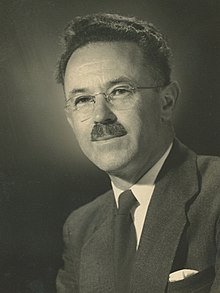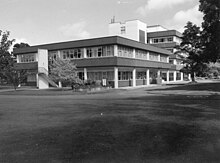Fergus Sheppard

Fergus George Frederick Sheppard (1908 – 1997) was a New Zealand architect, who served as the chief government architect from 1959 until his retirement in 1971. During his time in this capacity he was involved with the design of the Beehive, among hundreds of other public buildings.[1]
Personal life
[edit]Fergus Sheppard was born in 1908 in Auckland, the youngest of two, and son of bootmaker Lewis George Frederick Sheppard and Lillian Gertrude Sheppard (née Green), both first generationers to be born in New Zealand. He attended Auckland Grammar, and then studied at Auckland University.[2] In 1938, he married Marjorie Joan Targuse (1912 – 2008), daughter of Violet Targuse. They had four sons, one of whom was also an architect.
During World War Two, he served as a sapper (a combat engineer) and 1st lieutenant in the 4th Works Company.[2]
He died in 1997.
Professional career
[edit]
Sheppard was appointed as acting Government Architect with the Ministry of Works in February 1959, following the sudden death of Gordon Wilson, and fully assumed the role in May 1959.[3][4] During his tenure there was a boom in construction of state owned buildings, and one estimate is that Sheppard was responsible for approximately 900 building projects, including many government buildings, educational buildings, and state housing.[5] During this period, government architects designed buildings in a post-war modernist style. According to Duncan Joiner, the last to hold the title of Government Architect, "Many of the government buildings of this period are elegantly simple in concept, and economical in their use of materials and services, reflecting a New Zealand architectural design response to stringent import controls. It was a period of inventiveness, and during this time New Zealand engineers and architects established their international reputation for seismic design."[6]
Sheppard produced the detailed architectural drawings of the Beehive, the executive wing of the New Zealand parliament, from the original concept designs by Scottish architect Sir Basil Spence,[7] who is quoted as having remarked "It is not a Spence building, it is a Sheppard Building."[8][9]
Sheppard retired in 1971.[10]
He was elected a fellow of the Royal Society of Architects in 1969,[10] held public roles as the President of the Royal Society of Arts, and as a member of the Historic Places Trust. He was chairman of the Wellington Branch of the Institute of Architects and went to hold key roles with the New Zealand Institute of Architects at national level.[1]
The "Sheppard collection" held by the Architecture and Planning Library of the University of Auckland, was originally compiled by Sheppard in an effort to collect information on every New Zealand architect.[11]
Works
[edit]Among the buildings which Sheppard personally designed, collaborated on, or supervised the design of are:
| Building | Image | Location | Notes |
|---|---|---|---|
| Auckland: Central Police Station |  |
||
| Auckland: Commonwealth Pacific Cable Terminal | 1 Akoranga Drive, Northcote, Auckland | ||
| Auckland: Hobsonville Air Base's single men's barracks (1931),[12] now demolished.[13] | Hobsonville Point | ||
| Auckland: Middlemore Hospital (1947)[12] |  |
Otahuhu, Auckland | Originally intended for the treatment of wounded soldiers from overseas |
| Auckland: Naval Hospital, Devonport (1941)[12] |  |
Calliope Road, Devonport | |
| Christchurch: University of Canterbury, Science Block and Engineering School (1960)[10] | Riccarton, Christchurch | ||
| Huntly: Post Office (1939)[12] | |||
| Invercargill: Administrative Building (1960)[12] | |||
| Lower Hutt: Soil Bureau (now Learning Connexion Art School) (1960)[12] |  |
182 Eastern Hutt Rd, Taita, Lower Hutt | Sheppard and the director of the New Zealand Soil Bureau commissioned E. Mervyn Taylor to create a mural for the modernist building. With the restructuring of government departments in the early 1990s the Soil Bureau was rolled into a Crown Entity, and the building was tenanted and at some stage the mural was painted over.[14] |
| Masterton: Chief Post Office (now privately owned). | 122 Queen Street, Masterton | Featured a mural by E. Mervyn Taylor.[15] | |
| New Plymouth: Atkinson Building |  |
139-141 Devon Street West, New Plymouth | Six-storey, 50,000 square foot building.[16] |
| Palmerston North: Massey University Turitea Campus[17][5] |  |
Palmerston North | Colombo Hall is an example of late New Zealand international modernism, featuring a strong horizontal emphasis, a crisp, modulated appearance, and ground level open spaces, to provide transition between public and private areas as well as give the building an impression of lightness. Buildings designed later by Sheppard at Massey University feature a more Brutalist style.[5] |
| Putāruru: Post Office (now former post office)[17] | Tirau Street, Putāruru. | Circular design with delicate concrete arched roof shells. | |
| Rotorua: Forest Research Institute[10] | Rotorua | Features various forms of timber construction, to emphasize the versatility of timber as a building material. | |
| Ruakura: Laboratory block, Ruakura State Farm (1939)[12] | Ruakura State Farm | A large wooden one-storey structure consisting of two wings. | |
| Tokoroa: Interdenominational church (1940)[12] | |||
| Waimate: Public Hospital (1950)[12] | |||
| Wellington: Executive Wing, Parliament Buildings (The Beehive)[18] |  |
40 Bowen Street, Pipitea, Wellington | |
| Wellington: Government Centre (also known as the Government Printing Office, then Archives New Zealand)[19] |  |
Murphy Street, Wellington. | |
| Wellington: Meteorological Office (now MetService)[20] |  |
30 Salamanca Road, Kelburn, Wellington, 1962. | Four storey, free-standing reinforced concrete structure |
| Wellington: National Library of New Zealand[21] |  |
70 Molesworth Street, Wellington. | The facade is an inverted pyramid constructed of alternating bands of pronounced concrete panels and deep-set slot windows. The fortress-like exterior conveys an image of a national library that is a safe-keeper of materials; a deliberate architectural design strategy from a specific historical time when national libraries were less interested in intellectual and physical accessibility. The National Library was the last major building to be completed by the Ministry of Works and Development before it was dis-established in the 1980s. |
| Wellington Girls' College tower block[12] | |||
| Upper Hutt: Wallaceville Animal Research Centre, Laboratory & Administration Blocks, Department of Agriculture[22] |  |
Wallaceville, Upper Hutt |
References
[edit]- ^ a b "Collection: Fergus Sheppard New Zealand architects and buildings collection (the Sheppard Collection). | ArchivesSpace Public Interface". archives.library.auckland.ac.nz. Retrieved 2021-12-22.
- ^ a b "Sheppard, Fergus George Frederick, 1908-1997". natlib.govt.nz. January 1908. Retrieved 2021-12-23.
- ^ "People and Events". Official Architecture and Planning. 22 (7): 330–334. 1959. ISSN 2399-5327. JSTOR 44128358.
- ^ Noonan, Rosslyn J; New Zealand; Ministry of Works and Development (1976). By design: a brief history of the Public Works Department Ministry of Works 1870-1970. Wellington: Ministry of Works and Development. OCLC 229355033.
- ^ a b c "Search the List | Massey University Colombo Hall | Heritage New Zealand". www.heritage.org.nz. Retrieved 2021-12-22.
- ^ Centre for Building Performance Research, Faculty of Architecture and Design, Victoria University, 9th December 2005 : "about as austere as a Dior gown." : New Zealand architecture the 1960s : a one day symposium. Christine McCarthy, Victoria University of Wellington. Centre for Building Performance Research. Centre for Building Performance Research, Victoria University. 2005. ISBN 0475122801. OCLC 156746456.
{{cite book}}: CS1 maint: others (link) - ^ "40 years ago – the opening of the Beehive 28 February 1977 - New Zealand Parliament". www.parliament.nz. Retrieved 2021-12-22.
- ^ "Beehive Project: architect wants to bow out". Dominion. 16 June 1965.
- ^ Robin Skinner, "The Beehive: A difficult collaboration," in Mark Swenarton, Igea Troiani, Helena Webster (eds), "The Politics of Making," 2013, p. 143.
- ^ a b c d "Government Architect Retires". New Zealand News. 27 (1): 3. 1971–1972.
- ^ Treep, Lucy. "Metro — The closure of a specialist architecture library reminds us of its great impact". www.metromag.co.nz. Retrieved 2021-12-22.
- ^ a b c d e f g h i j File on Fergus Sheppard, S549f, in Sheppard Collection, University of Auckland archives.
- ^ Baker, Amy (2017-10-11). "Last set of Point's ex-Air Force barracks slated for demolishment". Stuff. Retrieved 2023-03-12.
- ^ "E. Mervyn Taylor: Soil Bureau, First Kumera Planting". Public Art Heritage Aotearoa New Zealand. 2016-05-13. Retrieved 2021-12-23.
- ^ "E. Mervyn Taylor: Masterton Post Office, Early Settlers". Public Art Heritage Aotearoa New Zealand. 2016-04-10. Retrieved 2023-03-12.
- ^ Sonius, Rachel. "Atkinson Building (1966-68)". ketenewplymouth.peoplesnetworknz.info. Retrieved 2021-12-22.
- ^ a b Long live the modern : New Zealand's new architecture, 1904-1984. Julia Gatley. Auckland, N.Z.: Auckland University Press. 2008. ISBN 978-1-86940-415-4. OCLC 228368046.
{{cite book}}: CS1 maint: others (link) - ^ Docomomo (International working party for documentation and conservation of buildings, sites and neighbourhoods of the modern movement) (2003). "Beehive, Wellington" (PDF).
- ^ "Guy Ngan: Government Printing Office, 1966". Public Art Heritage Aotearoa New Zealand. 2020-05-15. Retrieved 2021-12-22.
- ^ Boffa Miskell Ltd with Chris Cochran, "Wellington Heritage Building Inventory nonresidential buildings," 2001 (Wellington: Boffa Miskell, 2001).
- ^ DOCMOMO (international working party for documentation and conservation of buildings, sites and neighbourhoods of the modern movement) (2003). "National Library of New Zealand" (PDF).
- ^ "Wallaceville Laboratory Block: architectural drawings". AgResearch. Retrieved 2021-12-22.
